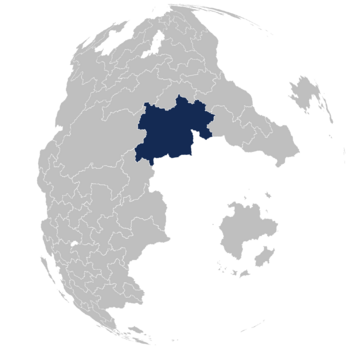Sartoria
This article is incomplete because it is pending further input from participants, or it is a work-in-progress by one author. Please comment on this article's talk page to share your input, comments and questions. Note: To contribute to this article, you may need to seek help from the author(s) of this page. |
Principality of Sartoria Principato di Sartoria | |
|---|---|
|
Flag | |
 | |
| Capital | Messelia |
| Largest city | Chiavere |
| Official languages | None |
| Other languages | Sartorian |
| Demonym(s) | Sartorian |
| Government | Federal Elective Parliamentary Monarchy |
• Princess | Giulia |
• First Councillor | Luciana Bergamaschi |
• Second Councillor | Fiorella Scola |
• Senate Speaker | Roberta Casellati |
• Chief Justice | Mario Boldrini |
| Legislature | Senate |
| Establishment | |
• Treaty of Messelia | 1768 |
• Merger Treaty | 1908 |
• Treaty of Regù | 1921 |
| Area | |
• Total | 3,078,415 km2 (1,188,583 sq mi) |
| Population | |
• Estimate | 186,723,882 |
• Density | 60.7/km2 (157.2/sq mi) |
| GDP (nominal) | estimate |
• Total | S/ 7,357 trillion |
• Per capita | S/ 39,400 |
| Currency | Vallo (v) |
| Time zone | UTC-5 |
| Date format | DD/MM/YYYY |
| Driving side | left |
| Internet TLD | .sr |
Sartoria, officially the Principality of Sartoria (Sartorian: Principato di Sartoria) is a country in Central Arcadia. It is located southwest of the Artemid Peninsula, bordering Istria to the west, Meridia to the southwest, Adler and Delfina to the east, and the Sartorian Sea to the south. With over 186 million inhabitants, it is the most populous country in Arcadia, and the second most populous country in the world.
What is today Sartoria was originally occupied by a number of civilisations during the first millenium, including the Artemid Empire in the northeast, the Vasarian Empire in the southwest, and a number of smaller kingdoms and principalities in the north, northeast, centre and south. Unification began in the 18th century when Messelia and Verale, as the first two realms to industrialise, signed the Treaty of Messelia to merge into a single country called Sartoria, after a horse that features prominently in the region's mythology. As Sartoria industrialised and more realms joined, the country grew from a confederacy to a federal principality.
By the late 19th century, the region was divided into several states, the main ones, in terms of size, population and economic development, being Sartoria in the south and North Sartoria in the north. When a violent conflict broke with the Republic of Laminia, Sartoria and North Sartoria formed a temporary alliance that resulted in the signing of the Merger Treaty in 1908. Unification was finally concluded when Tavoletro acceded, amid concerns that Sacuri Thought was getting out of control in the area.
Three times in its history Sartoria has waged war on the Sacuri, those who believe in the contents of the Sixth Scroll of Laterana, which tells of the battle between the goddess Laterana and his nemesis Sacur. The First Sacuri War took place between 1198 and 1237, and resulted in Sacuri's expulsion from modern-day Tavoletro. The Second Sacuri War took place between 1635 and 1647, when Sacuri assassinated the Duchess of Tavoletro and attempted to overthrow the Duchy.
The Third Sacuri War, fought between 1923 and 1935, is the most destructive war waged in Sartoria. When the Order of the Bloody Hand, the largest Sacuri group at the time, conquered Regù and began marching towards Messelia, the Sartorian Government began an unprecedented military campaign that resulted in the total defeat of the Bloody Hand in 1935 and the restoration of civilian government in the Eastern Realms. Following the War, the Senate passed the Cleansing Act and carried out the Pulizia, an effort to erase all Sacuri influence from society.
